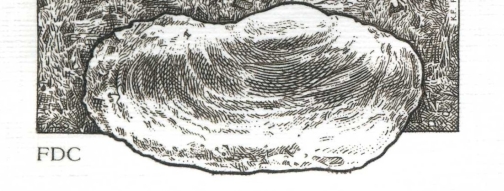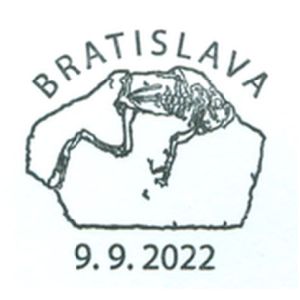the place where Paleontology and Paleoanthropology meets Philately
Slovakia
Fossils on stamps and postmarks of Slovakia
| << previous country | back to index | next country >> |
Contents:
- Country overview
- Philately of Slovakia
- Official stamps of Slovakia related to Paleontology
- Commemorative postmarks of Slovakia related to Paleontology
- References
- Acknowledgements
Slovakia, officially the Slovak Republic is a landlocked country in Central Europe.
It is bordered by the Czech Republic and Austria to the west, Poland to the north, Ukraine to the east and Hungary to the south.
Slovakia's territory spans about 49,000 square kilometers and is mostly mountainous. The population is over 5 million and comprises mostly ethnic Slovaks. The capital and largest city is Bratislava.
After the dissolution of the Austro-Hungarian Empire at the close of World War I, the Slovaks joined the Czechs to form Czechoslovakia.
During the interwar period, Slovak nationalist leaders pushed for autonomy within Czechoslovakia, and in 1939 Slovakia became an independent state allied with Nazi Germany.
Following World War II, Czechoslovakia was reconstituted and came under communist rule within Soviet-dominated Eastern Europe. The peaceful "Velvet Revolution" swept the Communist Party from power at the end of 1989 and inaugurated a return to democratic rule and a market economy.
On 1 January 1993, the country underwent a nonviolent "velvet divorce" into its two national components, Slovakia and the Czech Republic. [R1]
From 1918 to 1939 stamps of the Czechoslovak Republic were in use on Slovakia, marked either Česko-Slovensko or Československo.
Before then stamps of the Austro-Hungarian Empire were in use. Slovakia was part of Czechoslovakia between May 1945 and 31 December 1992, and Czech stamps were used during that time.
Since 1 January 1993, Slovakia became independent again as the Slovak Republic after splitting from the Czech Republic and stamps were issued from that date inscribed Slovensko as they had been between 1939 and 1945. Stamps of the former Czechoslovakia continued to be valid until 30 September 1993. [R2]
Official stamps of Slovakia related to Paleontology: fossils
| 21.04.2006 "Geological Locality Sandberg and Somoska" [1] | 09.09.2022 "Important Fossils from Slovakia" | |
 |
 |
|

|

|
| Prehistoric shell Flabelipecten solarium on stamp of Slovakia 2006 MiNr.: 532, Scott: 497a. | One shell of fossilized bivalve mollusk Panopea menardi shown on cachet of FDC of Slovakia 2006. |
Notes:
[1] In April 2006 Post of Slovakia issued an Mini-Sheet with two stamps and a tab in the middle, showing some unique geological localities of Slovakia: Sandberg and Somoska.
The first stamp in the mini sheet shows a landscape of Sandberg (from the German ‘sand hill’) region.
From the geological point of view, this area is in the transient sector between the Alps and the Carpathians.
The wider zone around Sandberg was formed by the sediments of the warm (subtropical) tertiary sea that transgressed into this region about 15 million years ago.
The shells of foraminifers, slugs, shellfish, and even shark teeth and the bones of large mammals form the majority of fossils found in the region.
Fractions of pecten shell, Flabelipecten solarium reproduced on the stamp, are amongst the most common fossils found in the region.
The bivalve mollusk Panopea menardi is reproduced on cachet and stylized ammonite shown on postmark of FDC cover.
Commemorative postmarks of Slovakia related to Paleontology: fossils
Legend is here| 21.04.2006 "Geological Locality Sandberg and Somoska" [FDC] | 09.09.2022 "Important Fossils from Slovakia" | |
 |
 |
 |
| 09.09.2022 "Important Fossils from Slovakia" | ||
 |
|
|
References:
- [R1] Slovakia:
Wikipedia,
WikiTravel,
Flag Counter
- [R2] Postal History and Philately of Slovakia:
Wikipedia,
Links to official website of the Post Authority, stamp catalog and a list of new stamps of Slovakia are here. - [R3] Panopea menardi: Wikipedia, marinespecies.org.
Acknowledgement:
Many thanks to Dr. Peter Voice from Department of Geological and Environmental Sciences, Western Michigan University, for reviewing the draft page and his valuable comments.
| << previous country | back to index | next country >> |